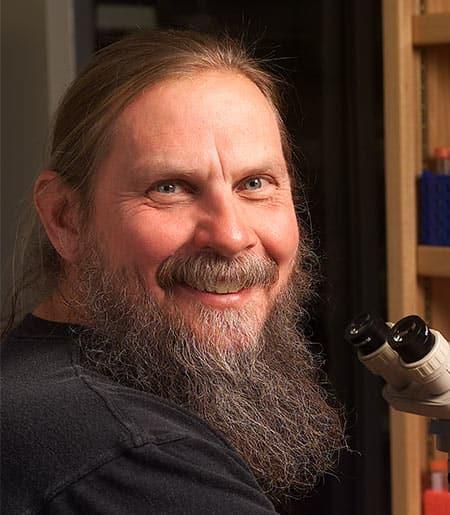Overview
The Ealick group studies the structure and function of proteins using X-ray crystallography. The main goals of the research are to understand the structural basis of enzyme mechanism, to design small molecules of potential chemotherapeutic importance, to study the basis of protein evolution, and to expand the tools available to macromolecular crystallographers.
Research Focus
We use X-ray crystallography to study the three-dimensional structures of proteins. The structural information is used for drug design, protein engineering, to understand catalytic mechanisms, and to explore protein evolution. Our main projects include studies of enzymes involved in purine and pyrimidine nucleotide metabolism, studies of enzymes involved in co-factor biosynthesis, especially thiamin and pyridoxal 5'-phosphate (PLP) biosynthesis, and enzymes involved in polyamine, purine, and pyrimidine and diphthamide biosynthesis.
Systematic investigation of an entire biochemical pathway provides important clues about protein evolution. Because of the role of purine and pyrimidine nucleotide metabolism and polyamines in diseases such as cancer and viral infection, many of the enzymes involved are targets for drug design. Many of the reactions catalyzed by enzymes in the co-factor biosynthesis pathways involve unprecedented chemistry and elucidation of catalytic mechanisms is a major goal. In addition, by studying these enzymes, we have also discovered interesting evolutionary links to other pathways. Please see our Group Webpage for additional information about our personnel, publications, and structures.
As Director of the Northeastern Collaborative Access Team (NE-CAT), we operate two undulator beamlines, both of which are capable of microdiffraction experiments, at Sector 24 of the Advanced Photon Source (APS) at Argonne National Laboratory in Argonne, Illinois. Please see NE-CAT for more information about this project.
Publications
- Sasaki E, Zhang X, Sun HG, Lu MY, Liu TL, Ou A, Li JY, Chen YH, Ealick SE, and Liu HW. Co-opting sulphur-carrier proteins from primary metabolic pathways for 2-thiosugar biosynthesis. Nature 510:427-431 (2014).
- Chatterjee A, Abeydeera ND, Bale S, Pai PJ, Dorrestein PC, Russell DH, Ealick SE, and Begley TP. Saccharomyces cerevisiae THI4p is a suicide thiamine thiazole synthase. Nature 478:542-6 (2011).
- Zhang Y, Zhu X, Torelli AT, Lee M, Dzikovski B, Koralewski RM, Wang E, Freed J, Krebs C, Ealick SE, and Lin H. Diphthamide Biosynthesis Requires an Organic Radical Generated by an Iron-Sulphur Enzyme. Nature 465:891-896 (2010).
- Chatterjee A, Li Y, Zhang Y, Grove TL, Lee M, Krebs C, Booker SJ, Begley TP, and Ealick SE. Reconstitution of ThiC in thiamine pyrimidine biosynthesis expands the radical SAM superfamily. Nat. Chem. Biol. 4:758-65 (2008).
- Ealick SE, Cook WJ, Vijay Kumar S, Carson M, Nagabhushan TL, Trotta PP, and Bugg CE. Three-Dimensional Structure of Recombinant Human Interferon-ɣ. Science 252:698-702 (1991)
